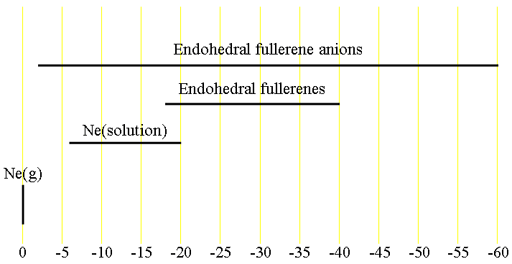(21Ne) Neon NMR
Neon has one naturally occurring NMR active nucleus, 21Ne. It has a spin of 3/2 and is therefore quadrupolar although it is always found in highly symmetrical environments so its signals are not very broad. The isotope 21Ne has a very low natural abundance of 0.27% combined with a very low receptivity and so is only observable when enriched (very expensive). The chemistry of neon is limited to that of endoherdral fullerenes. Due to the extreme expense and difficulty in preparing samples, there is only one high resolution NMR study of 21Ne in the literature: P. Deihl, O. Muenster and J. Jokisaari, Chem. Phys. Lett., 178, 147-149. This paper deals with the dependence of 21Ne chemical shift (fig. 1) with solvent. We have no experience of 21Ne in our laboratory although we could measure it if provided with a suitable sample.
Fig. 1. Chemical shift ranges for 21Ne NMR
(endohedral fullerenes have never been measured and their chemical shifts are as theoretically predicted)

Properties of 21Ne
| Property | Value |
|---|---|
| Spin | 3/2 |
| Natural abundance | 0.27% |
| Chemical shift range | 60 ppm, from -60 to 0 |
| Frequency ratio (Ξ) | 7.894296% |
| Reference compound | 21Ne gas |
| Linewidth of reference | 5 Hz |
| T1 of reference | 0.1 s |
| Receptivity rel. to 1H at natural abundance | 6.64 × 10-6 |
| Receptivity rel. to 1H when enriched | 2.46 × 10-3 |
| Receptivity rel. to 13C at natural abundance | 0.0391 |
| Receptivity rel. to 13C when enriched | 14.5 |
| Linewidth parameter | 140 fm4 |
Safety note
Some of the materials mentioned here are very dangerous. Ask a qualified chemist for advice before handling them. Qualified chemists should check the relevant safety literature before handling or giving advice about unfamiliar substances. NMR solvents are toxic and most are flammable. Specifically, neon displaces oxygen in the air and is therefore an asphyxiant.